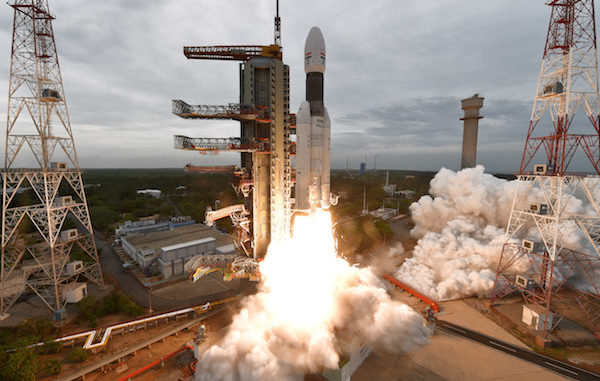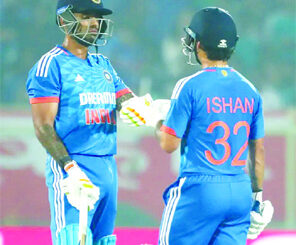
NEW DELHI /NEW YORK(TIP): On July 22 India created history when India’s Geosynchronous Satellite Launch Vehicle GSLV MkIII-M1, successfully launched the 3840 kgChandrayaan-2 spacecraftinto an earth orbit. Launch of Chandrayaan-2 was originally scheduled for 14 July 2019 at 21:21 UTC (15 July 2019 2:51 IST) but was called off due to a technical snag noticed while filling the cryogenic engine of the rocket with helium. Developed by the Indian Space Research Organisation(ISRO), the mission was launched from the second launch pad at Satish Dhawan Space Centreon 22 July 2019 at 2.43 PM IST (09:13 UTC) to the Moon.
Chandrayaan 2 Indian lunar mission will boldly go where no country has ever gone before — the Moon’s south polar region. Through this effort, the aim is to improve our understanding of the Moon — discoveries that will benefit India and humanity as a whole. These insights and experiences aim at a paradigm shift in how lunar expeditions are approached for years to come — propelling further voyages into the farthest frontiers.
Chandrayaan 2 is:
- 1stspace mission to conduct a soft landing on the Moon’s south polar region
- 1stIndian expedition to attempt a soft landing on the lunar surface with home-grown technology
- 1stIndian mission to explore the lunar terrain with home-grown technology
A successful landing would make India 4thcountry ever to soft land on the lunar surface after the space agencies of the USSR, US and China
Prime Minister Narendra Modi congratulated Team ISRO for the successful launch of Chandrayaan-2.
ISRO Chairman Dr K Sivan congratulated the launch vehicle and satellite teams involved in this challenging mission. “Today is a historical day for Space Science and Technology in India. I am extremely happy to announce that GSLV MkIII-M1 successfully injected Chandrayaan-2 into an orbit of 6000 Km more than the intended orbit and is better.”
“Today is the beginning of the historical journey of India towards Moon and to land at a place near south pole to carry out scientific experiments to explore the unexplored. On July 15, 2019 ISRO intelligently observed a technical snag, Team ISRO worked out, fixed and corrected the snag within 24 hours. For the next one and a half day, the required tests were conducted to ensure that corrections made were proper and in right direction. Today ISRO bounced back with flying colours.” Dr. Sivan said.
The Moon is the closest cosmic body at which space discovery can be attempted and documented. It is also a promising test bed to demonstrate technologies required for deep-space missions. Chandrayaan 2 attempts to foster a new age of discovery, increase our understanding of space, stimulate the advancement of technology, promote global alliances, and inspire a future generation of explorers and scientists.
Moon provides the best linkage to Earth’s early history. It offers an undisturbed historical record of the inner Solar system environment. Though there are a few mature models, the origin of Moon still needs further explanations. Extensive mapping of lunar surface to study variations in lunar surface composition is essential to trace back the origin and evolution of the Moon. Evidence for water molecules discovered by Chandrayaan-1, requires further studies on the extent of water molecule distribution on the surface, below the surface and in the tenuous lunar exosphere to address the origin of water on Moon.
The lunar South Pole is especially interesting because of the lunar surface area here that remains in shadow is much larger than that at the North Pole. There is a possibility of the presence of water in permanently shadowed areas around it. In addition, South Pole region has craters that are cold traps and contain a fossil record of the early Solar System.
Chandrayaan-2 will attempt to soft land the lander -Vikram and rover- Pragyan in a high plain between two craters, Manzinus C and Simpelius N, at a latitude of about 70° south. Chandrayaan-2 is India’s second mission to the moon. It comprises a fully indigenous Orbiter, Lander (Vikram) and Rover (Pragyan). The Rover Pragyan is housed inside Vikram lander.
Former Prime minister Atal Behari Vajpayeeannounced the Chandrayaanproject on course in his Independence Day speech on 15 August 2008. The mission was a major boost to India’s space program. The idea of an Indian scientific mission to the Moon was first mooted in 1999 during a meeting of the Indian Academy of Sciences. The Astronautical Society of India (AeSI) carried forward the idea in 2000. Soon after, the Indian Space Research Organization (ISRO) set up the National Lunar Mission Task Force, which concluded that ISRO has the technical expertise to carry out an Indian mission to the Moon. In April 2003 over 100 eminent Indian scientists in the fields of planetary and space sciences, Earth sciences,physics, chemistry, astronomy, astrophysics and engineering and communication sciences discussed and approved the Task Force recommendation to launch an Indian probe to the Moon. Six months later, in November, the Indian government gave the nod for the mission.

Chandrayaan-1was launched by ISRO in October 2008 and operated until August 2009. The mission included a lunar orbiter and an impactor.India launched the spacecraft using a PSLV-XLrocket, serial number C11, on 22 October 2008 The mission was a major boost to India’s space program,as India researched and developed its own technology in order to explore the Moon. The vehicle was inserted into lunar orbit on 8 November 2008.
Now the whole world is waiting for September 7 – a successful landing of Chandrayaan-2would make India 4thcountry ever to soft land on the lunar surface and will boldly go where no country has ever gone before.





Be the first to comment